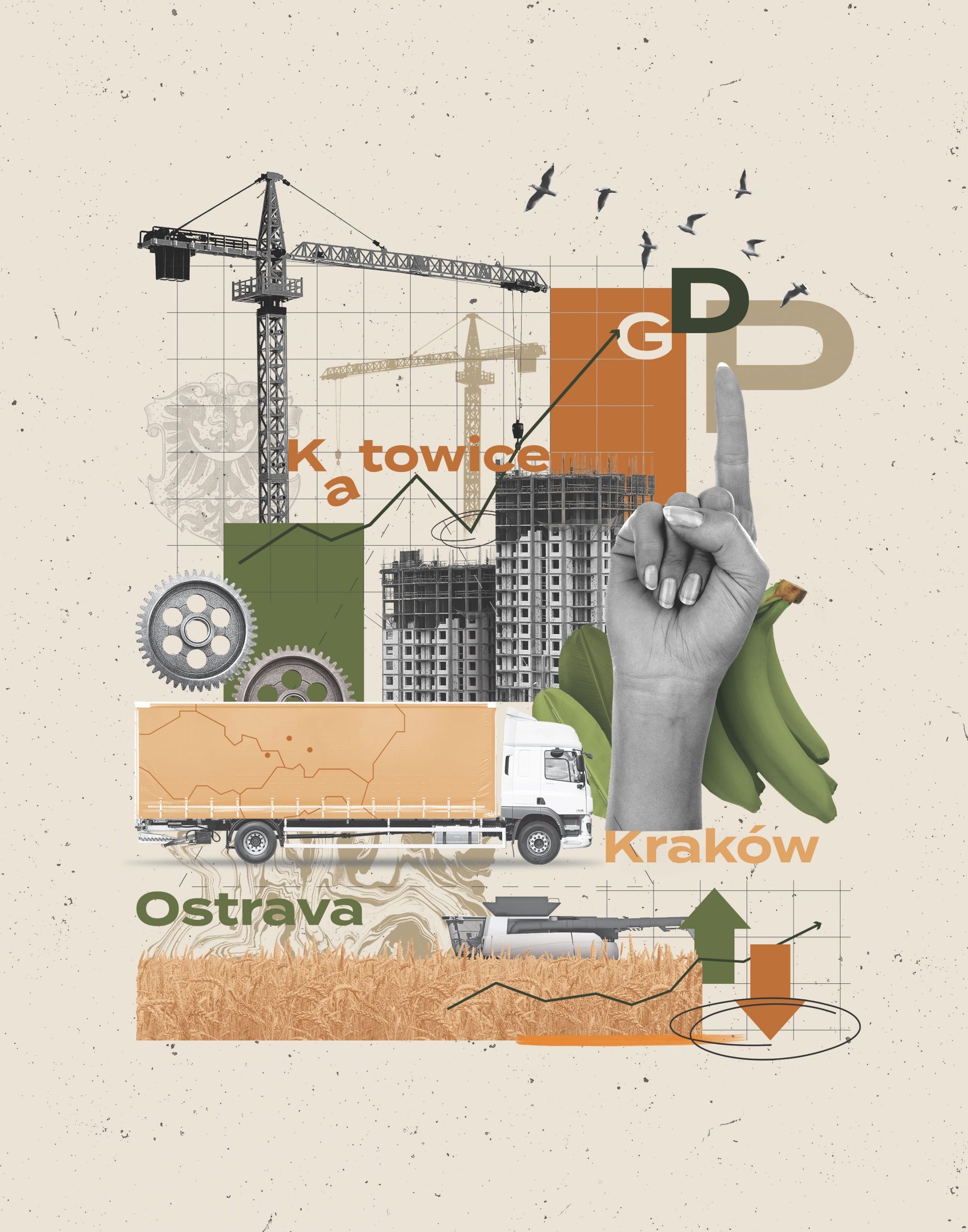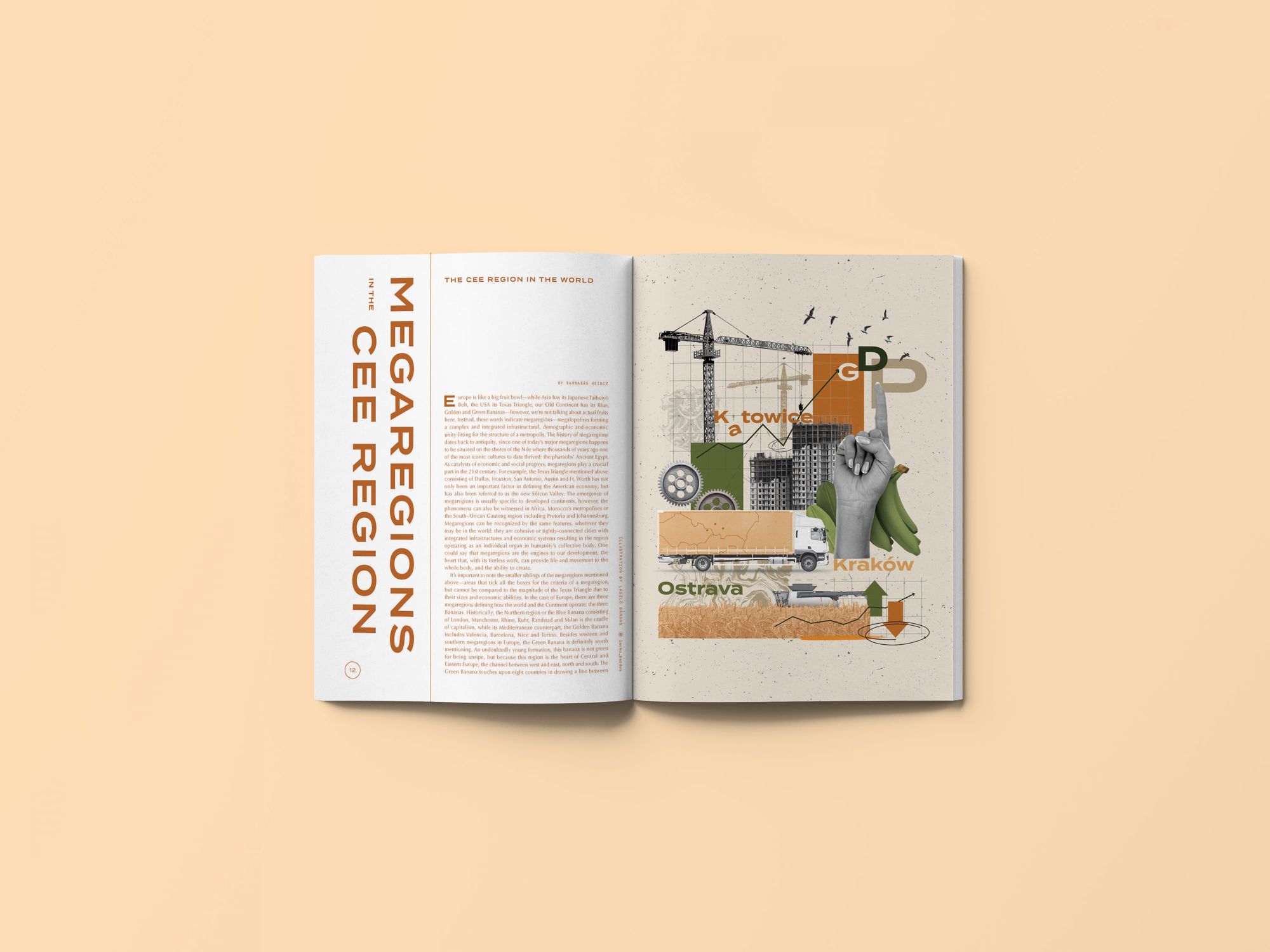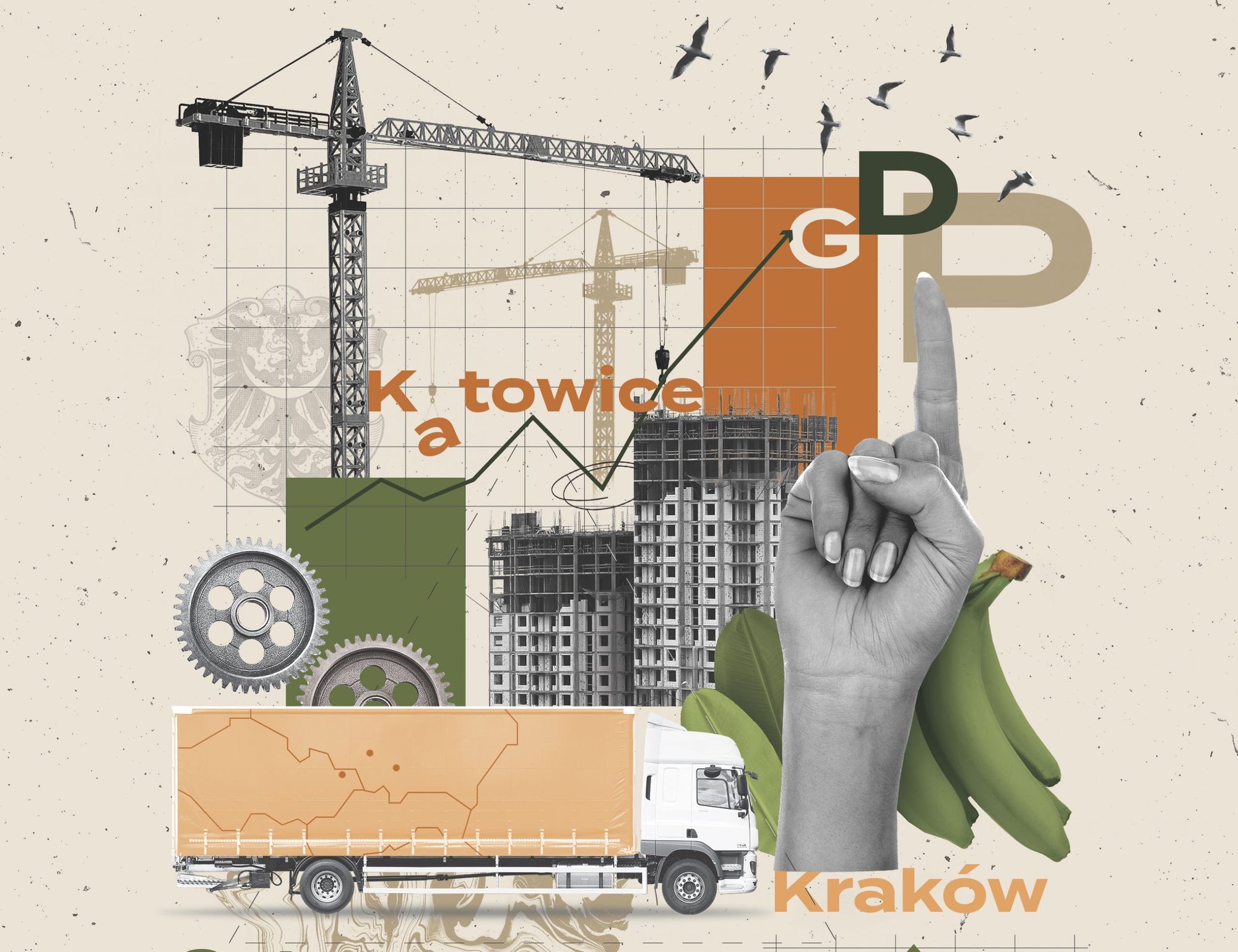This article was published in print in Hype&Hyper 2022/2.
Illustration by László Bárdos
Europe is like a big fruit bowl—while Asia has its Japanese Taiheiyō Belt, the USA its Texas Triangle, our Old Continent has its Blue, Golden and Green Bananas—however, we’re not talking about actual fruits here. Instead, these words indicate megaregions—megalopolises forming a complex and integrated infrastructural, demographic and economic unity fitting for the structure of a metropolis. The history of megaregions dates back to antiquity, since one of today’s major megaregions happens to be situated on the shores of the Nile where thousands of years ago one of the most iconic cultures to date thrived: the pharaohs’ Ancient Egypt. As catalysts of economic and social progress, megaregions play a crucial part in the 21st century. For example, the Texas Triangle mentioned above consisting of Dallas, Houston, San Antonio, Austin and Ft. Worth has not only been an important factor in defining the American economy, but has also been referred to as the new Silicon Valley. The emergence of megaregions is usually specific to developed continents, however, the phenomena can also be witnessed in Africa, Morocco’s metropolises or the South-African Gauteng region including Pretoria and Johannesburg. Megaregions can be recognized by the same features, wherever they may be in the world: they are cohesive or tightly-connected cities with integrated infrastructures and economic systems resulting in the region operating as an individual organ in humanity’s collective body. One could say that megaregions are the engines to our development, the heart that, with its tireless work, can provide life and movement to the whole body, and the ability to create.

It’s important to note the smaller siblings of the megaregions mentioned above—areas that tick all the boxes for the criteria of a megaregion, but cannot be compared to the magnitude of the Texas Triangle due to their sizes and economic abilities. In the case of Europe, there are three megaregions defining how the world and the Continent operate: the three Bananas. Historically, the Northern region or the Blue Banana consisting of London, Manchester, Rhine, Ruhr, Randstad and Milan is the cradle of capitalism, while its Mediterranean counterpart, the Golden Banana includes Valencia, Barcelona, Nice and Torino. Besides western and southern megaregions in Europe, the Green Banana is definitely worth mentioning. An undoubtedly young formation, this banana is not green for being unripe, but because this region is the heart of Central and Eastern Europe, the channel between west and east, north and south. The Green Banana touches upon eight countries in drawing a line between Gdańsk, Warsaw, Łódź, Wrocław, Katowice, Kraków, Prague, Bratislava, Vienna, Budapest, Zagreb, Ljubljana and Trieste, integrating the most developed cities and developing economies of Europe. The Green Banana starts from and ends with port cities and includes seven capitals marking the boundaries of one of the most important commercial areas of Europe, which is not only financially strong, but possesses the ability for further development. Nations in the CEE region have been gradually entering the elite club of developed countries, with dynamically growing economies and crisis-resisting features that helped them survive even the toughest recessions. We don’t have to go far back in time: on the scale of the European Union, the CEE region stood its ground the best during the shutdown and crisis caused by the Covid-19 pandemic, and is still showing a great growth in GDP. The monetary policy of the countries in the Green Banana is just an added bonus, operating with a secure and low general government deficit as opposed to the southern members of the European Union, and an openness to innovation that invites high added value investments. The Green Banana, however, is considered to be a smaller megaregion, and some even doubt its existence due to its low population number and density. Demographic unity is of key importance for a megaregion, and the area of the Green Banana is home to 50 million people where the largest city counts merely 3.5 million inhabitants. These relatively small numbers only seem low on an international scale—they are actually quite high in Europe, especially if we take into account that the population of 50 million people is roughly 10% of the total population of the European Union.
There are centres in the Green Banana where the most power is concentrated, marking the catalysts of development in the region. Naturally, capitals and their agglomerations are always urban centres, however, it’s more exciting to look into how crucially important units form around historically densely populated and industrialised areas. The largest coalfield of the region is the Upper Silesian Coal Basin, so it comes as no surprise that the surrounding area is one of the most developed and largest in the region: the Górnośląsko-Zagłębiowska Metropolia or GZM for short. The GZM with a population of 2.2 million, was founded after long deliberation in June 2017 by a decree of Poland’s Council of Ministers as an expansion of the already existing Metropolitan Association of Upper Silesia. As a historic background, the union had already been formed ten years earlier in Świętochłowice by 14 core cities. The purpose of the GZM is to function as the manager of the effective operation of the megaregion while maintaining a strong urban and industrially developed area with an internationally competitive profile and unified management of all infrastructure. The financial assets, however, have to be provided, therefore, the GZM receives 5% of the income tax of its residents and participating municipalities. The concept of the GZM is not only fantastic for connecting the population and economies of the cities in the region, but also for creating international competitiveness due to the integrated systems, unified image and action that is key to continuous development. Staying with Katowice, the Katowice metropolitan area exceeding the boundaries of the GZM is also worth mentioning, even without its own, tangible management, this unified bloc is a prominent metropolitan area on a European scale with its 3.5 million population. National borders however, do not play an important role in megaregions, and if we take the population density and economic gravity of Central Europe into account, the Kraków-Katowice-Ostrava line is the heart of the region. Showing similarities with the Rhine-Ruhr metropolitan region, the Upper Silesian metropolitan area reaching from Czechia all the way to Kraków, went through industrialization during the 19th-20th century and counts roughly 7 million people. It came as no surprise that during the Covid-19 lockdowns, this part of the Czech-Polish border received a unique status due to the unbelievably developed economic integration of the region.
Leaving the centre of the Green Banana, it’s worthwhile taking a closer look at its northern starting point Tricity (Trójmiasto). Connecting the Polish port cities of Pomeranian Voivodeship (Gdańsk, Gdynia, and Sopot) the region is home to 1-1.5 million people and is responsible for a great deal of sea trade. In 2019, the ports of Gdańsk és Gdynia handled the transaction of roughly 76 million tons of products, making Tricity the second largest port complex on the Baltic Sea after the Ust-Luga port in Russia. Besides creating a complex economic environment, Tricity is an important vacation spot as well, the gate to the Polish Riviera.
We can’t leave one of the most developed metropolitan areas of the Green Banana unmentioned when talking about city trios. American travel books call it the Golden Triangle, Vienna, Bratislava and Budapest are known for their beautiful historic heritage, and this trio was not only powerful for being highly developed during the 19th century, but today as well. In terms of economic connections and gravity, this is the largest economic and metropolitan region after Kraków, Katowice and Ostrava, that rightfully earned its name due to the average salaries and standard of living in the area marked by the Hungarian, Slovakian and Austrian capital cities.
The power of the CEE region’s Green Banana might further accelerate as analysts had already predicted in 2010 that the Blue Banana of Western Europe was going to shift towards the East, as after the fall of the Berlin Wall, the centre of Western economy migrated to Germany instead of the Benelux States and former areas of West Germany. The Eastern shift of the Blue Banana creates greater opportunities for the region as there is only one thing better than the integration into a megaregion: the organic integration and mutual connection of two megaregions.

Prefer to read it in print? Order the fourth issue of Hype&Hyper magazine from our online Store!

Alina Pash – A good witch











